The Long Tail Keyword Mastery Guide: More Traffic, Less Competition
Daniel Trick
Dec 15, 2023
12 min read
Long-tail keywords can be a game-changer for your agency.
These longer search queries are easy to rank for, and the traffic they generate is more conversion-ready.
That means more sales for your clients.
In this guide, we’ll reveal everything you need to know to find and rank for long-tail keywords.
We’ll cover:
- What long-tail keywords are
- Why you should focus on the long tail
- The best free and paid tools for long-tail keyword research
- How to find long-tail keywords
- How to optimize for long-tail keywords
What Are Long-Tail Keywords?
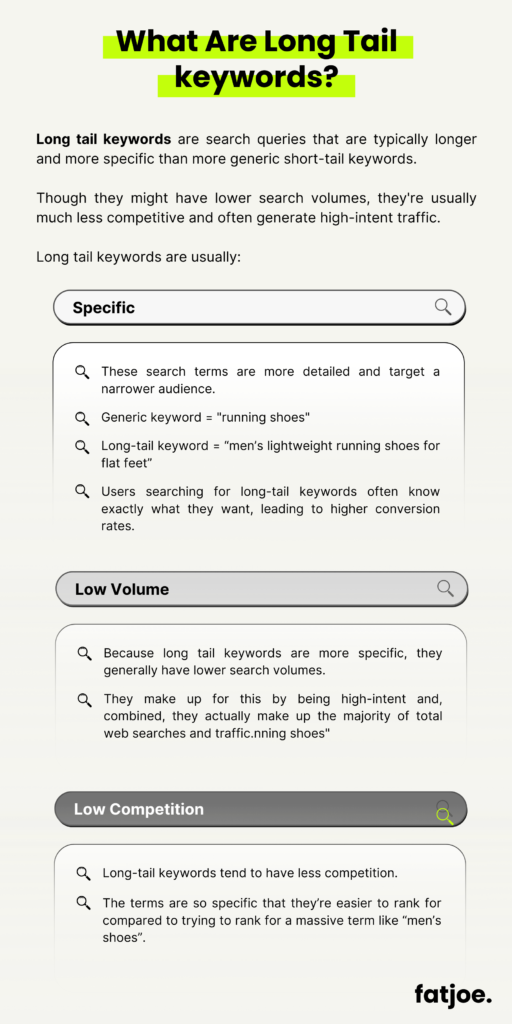
Long-tail keywords are search queries that are typically longer and more specific than more generic short-tail keywords. While they tend to have lower search volumes, they are usually much less competitive.
They also attract more conversion-ready traffic.
Here are the three primary characteristics of a long-tail keyword:
Specific
Long-tail keywords are more specific. They are more detailed and target a narrower audience.
Generic keyword = “running shoes”
Long-tail keyword = “men’s lightweight running shoes for flat feet”
Users searching for long-tail keywords often know exactly what they are looking for. That can lead to higher conversion rates.
Low Volume
Because long-tail keywords are more specific, they generally have lower search volumes.
That doesn’t mean they’re less valuable. Collectively, long-tail keywords account for the vast majority of search-driven traffic.
Low Competition
Long-tail keywords tend to have less competition.
If you tried to rank for a highly competitive term like “men’s shoes,” you’d be up against thousands of websites and industry giants.
It’s much easier to rank for a long-tail keyword like “most comfortable white sneakers for wide feet.”
Why Are They Called “Long-Tail” Keywords?
If you think they’re called ’long-tail’ keywords because they contain more words, you’re wrong.
The term was coined back in 2003 by internet technologies writer Clay Shirky. He wrote a piece titled “Power Laws, Weblogs, and Inequality”. This article discussed how a handful of websites had a lot of backlinks while most only had a handful.
If you organize the data into a graph – the y-axis counting the number of links a website has, the x-axis displaying websites (from most popular to least popular) – you will see a trend similar to this.
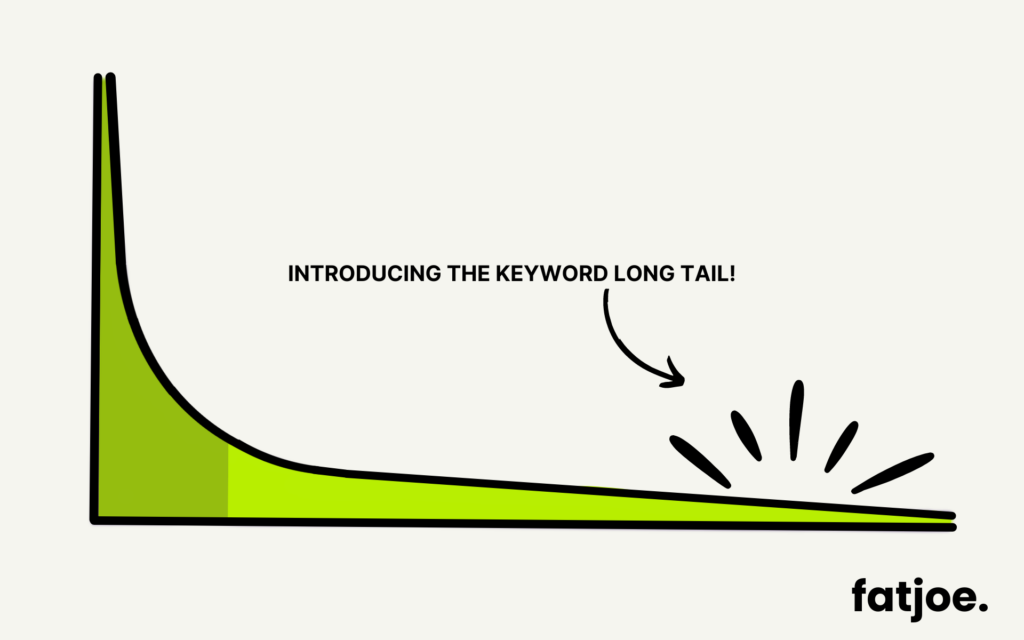
At the head of the curve (in green), you have a small number of websites with backlinks. The tail (in yellow) consists of websites with little to no backlinks.
If you apply the same concept to keywords, you have a small number of head keywords that generate a lot of searches. In the long tail, you have millions of keywords with low search volumes.
But, collectively, these long-tail keywords account for most searches.
An Ahrefs study estimates that nearly 95% of all keywords get 10 or fewer monthly searches.
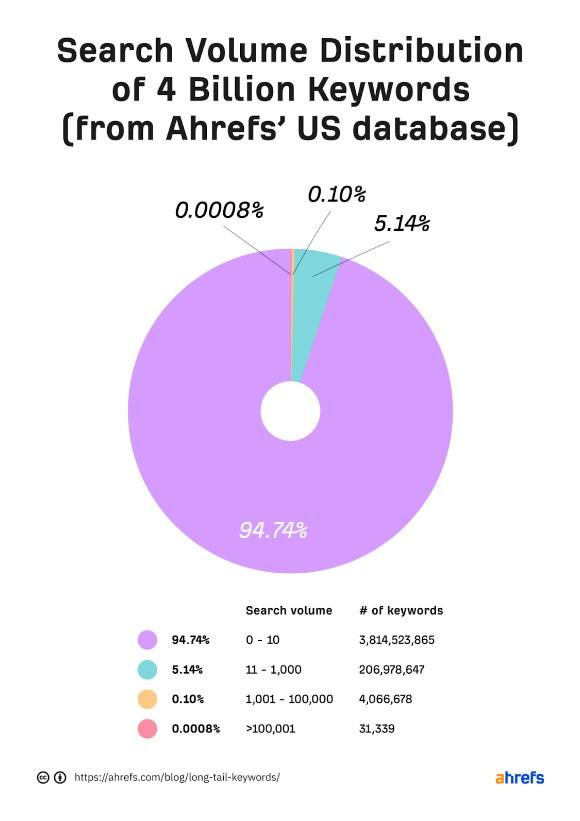
That means that 95% of the time, people type in long-tail keywords when they use Google.
Why Are Long-Tail Keywords Important?
Targeting long-tail keywords can be an effective SEO strategy, especially for agencies looking to prove their worth to new clients.
Here’s why:
Higher Conversion Rates
Long-tail keywords are specific and usually tied to a clear want or need.
For example, someone searching for “vintage wooden bookshelf designs for small apartments” is not just casually browsing.
They have a very specific item in mind.
When they land on a page optimized for that long-tail keyword, their search intent strongly aligns with the content or product.
That can easily translate into a conversion.
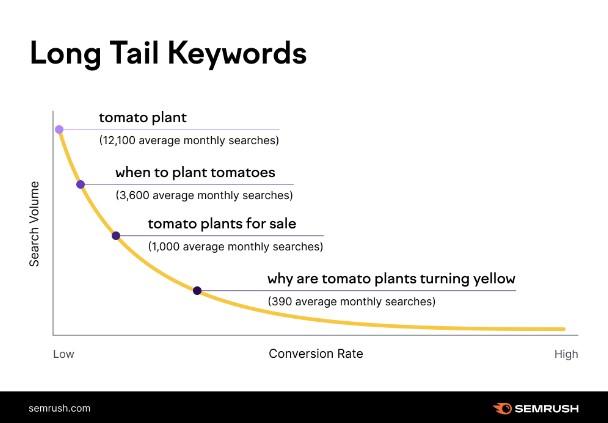
Less Competition
Established giants dominate the rankings for competitive broad terms like “hiking shoes.”
A long-tail keyword like “men’s waterproof hiking shoes in size 11” is more specific and less likely to be targeted by every shoe seller out there.
This reduced competition makes ranking on the first page of search results easier.
Here’s a pro tip.
Ditch the SEO jargon when you’re talking to clients about your strategy. Instead of saying ’long-tail’ keywords, say that you will target low-competition keywords.
Instead of saying “long tail” or “head” keywords – try saying “high competition” or “low competition” keywords
Your marketing director/CEO will stop laughing at you behind your back
…and most of the team will agree it’s a good idea to go after low competition keywords.
— Stephen Kenwright (@stekenwright) May 17, 2019
Achieve Quicker SEO Wins
You need a lot of authority to rank for broad, competitive keywords.
Building that authority takes time and a lot of link building and content.
Long-tail keywords are much more achievable.
Targeting specific long-tail queries can help you achieve higher rankings faster.
If you are just getting started with SEO, focus on getting quick wins 👇
Go after long tail keywords that are highly relevant to your product and targeted audience 🔥
— Roberto Robles 😺 🚀 (@robertodigital_) October 27, 2021
You shouldn’t give up entirely on shorter, head terms. But you need to be smart about where you invest your time and resources.
Every piece you publish targeting long-tail keywords contributes to your topical authority.
Over time, this can make it easier for you to compete for broader, more competitive terms.
How to Identify Long-Tail Keywords
The first step is to gear up. The right tools can make long-tail keyword research much easier.
The Best Free Long-Tail Keyword Research Tools
Sometimes, the best resources come without a price tag.
Here’s a breakdown of the best free long-tail keyword research tools:
The search engine provides three easy ways to find long-tail keywords.
And because this data comes directly from Google, you know these are terms that real users are searching for.
Google Autocomplete
Google Autocomplete can provide a bunch of long-tail keyword ideas.
Start typing in a relevant topic or head term in the Google search bar.
Before you press “Enter,” you’ll notice a dropdown list suggesting ways to complete your query.

These suggestions are based on actual searches by users. They reflect popular and recent search trends related to your primary keyword.
Related Searches
Once you’ve searched on Google, scroll to the bottom of the search engine results page (SERP).
You’ll find a section titled “Related searches.”
This section provides keyword variations and expansions of your initial search term. It can be a great place to find long-tail keyword opportunities.
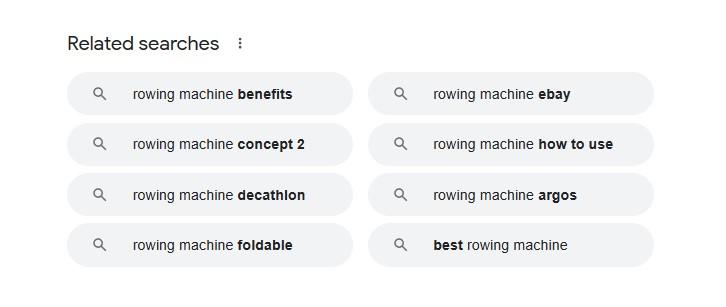
You can expand your search by clicking one of these keyword suggestions.
Scroll down to “Related searches” on the new SERP, and you’ll find a fresh list of long-tail keywords based on that search term.
People Also Ask Section
The “People Also Ask” (PAA) box displays a collection of questions related to your primary keyword.
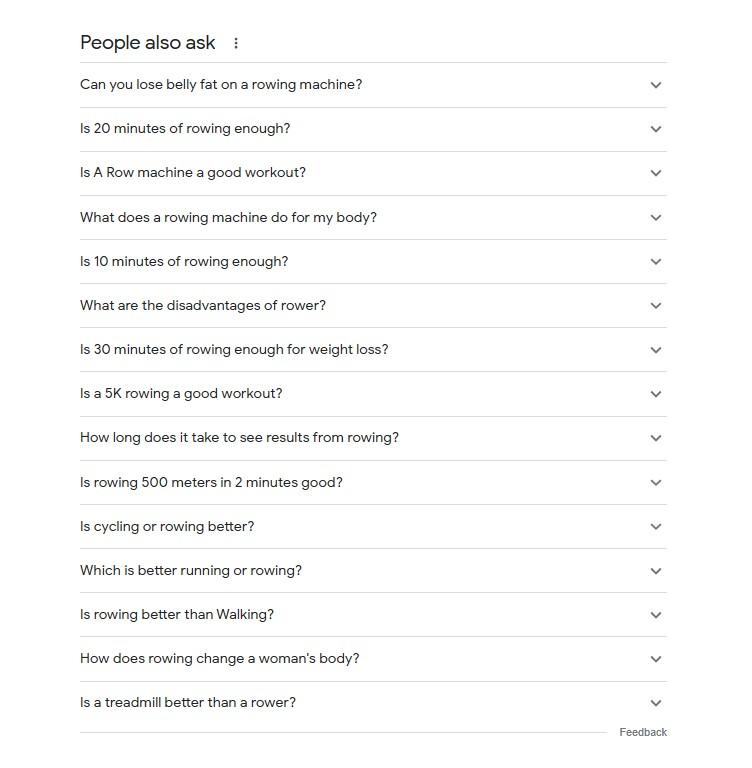
Each question is a potential long-tail keyword opportunity.
Tip: More will show up whenever you click to expand one of these questions.
This is one of the most common Google SERP features. A 2023 study found that PAA boxes appear on 78.85% of SERPs.
Google Ads Keyword Planner
Keyword Planner is a free tool designed to help advertisers build effective Google Ads campaigns. However, it’s also an excellent tool for organic keyword research.
Enter a broad keyword related to your niche, and you’ll see a list of keyword suggestions based on your input.
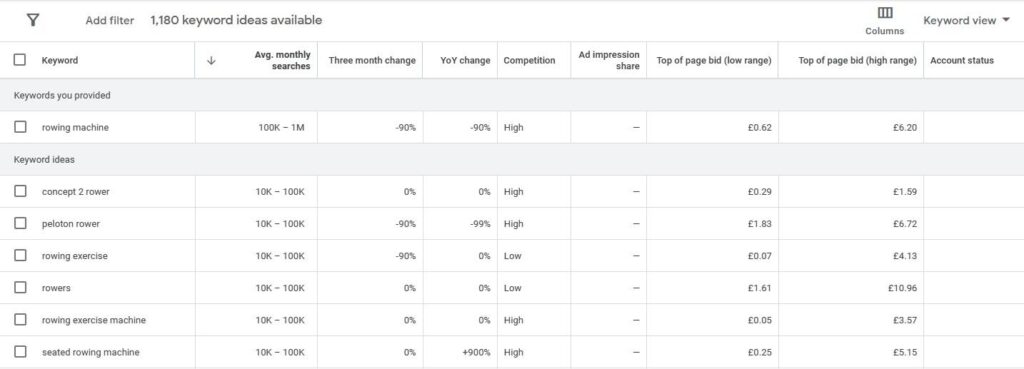
These initial results will likely be broader head terms.
So, you need to use the Keyword Planner filters to uncover long-tail opportunities.
You can include or exclude certain words and exclude branded keywords.
Then, sort the results by “Avg. monthly searches” or “Competition” to narrow in on long-tail keywords.

Use Forums like Reddit and Quora
Platforms like Reddit and Quora are full of real-life questions, concerns, and discussions.
They are one of the best places to find keyword opportunities.
Begin by entering a broad keyword related to your niche. This will give you an overview of the discussions around the term.
On Reddit, you can explore different threads in relevant subreddits.

Reddit has become so popular that all tactics are dedicated to Reddit SEO to leverage its popularity and boost your own client’s positioning.
On Quora, review the top answers and questions for your broad keyword search.

You’ll often find complete long-tail keywords in the form of user questions.
Note down any phrases or questions frequently appearing in post titles and popular comments.
Later, you can run these keywords through Ahrefs or Semrush to check the search volume and competition.
The Best Paid Long-Tail Keyword Research Tools
You can find some great keyword opportunities using free tools. But you’ll need to invest in a paid tool to verify these terms are worth targeting.
Paid tools also offer lots of other keyword research features to help you find more search terms.
Ahrefs
Ahrefs is one of our go-to keyword research tools here at fatjoe.
You can get details on keyword search volume, competition, and traffic potential.

Also worth noting that Ahrefs has superb filtering options.
You can quickly filter out keywords based on word count, search volume data, included/excluded phrases, and more.
It also has the most comprehensive collection of data.
For example, searching for the word “cat” returns 5,673,255 keyword ideas on Ahrefs. That’s crazy impressive!
Semush provides 3,674,338. If you go for a budget option like Mangools, they only give a maximum of 700. Google Keyword Planner provides just 515 keywords.
Semrush
Semrush has a powerful Keyword Magic Tool.
Like Ahrefs, it provides a breakdown of keyword difficulty, competition, and search volume.
You also get a ton of keyword ideas.
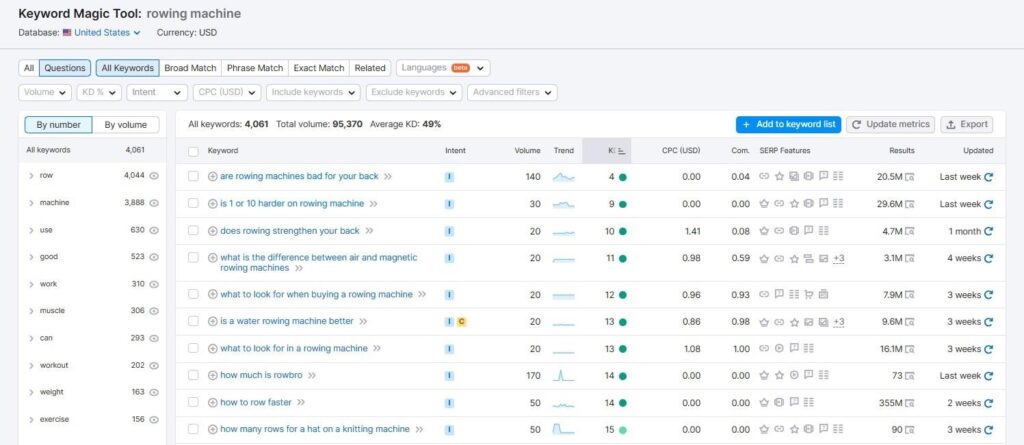
One of the best ways to use Semrush and Ahrefs is to click the ‘Questions’ tab. This reveals the questions people have about specific keywords.
Another advantage of these paid tools is that they come with competitor analysis features.
You can spy on your competitors to see which long-tail keywords they currently rank for.
Stuck on keyword research? Start with your competitors.
+ Find 3-5 of your top competitors.
+ Plug their sites into Ahrefs/Semrush tool.
+ Extract their top ranking keywords and pages.
+ Identify low competition long-tail keywords to target.
+ Create high quality helpful… pic.twitter.com/vgGCBqDtIH
— Sarvesh Shrivastava (@bloggersarvesh) September 19, 2023
This is a good way to uncover long-tail keywords you might have overlooked.
Query Hunter
Query Hunter is a keyword tool that helps you identify underserved search queries. These are terms that your content doesn’t currently mention but are generating impressions in search results.
It works by connecting with your Google Search Console account to a Chrome Extension. It’s also available as a WordPress Plugin.
Once installed, simply visit a page on your website and open the extension.
Query Hunter will show you the keywords the page is currently ranking for and generating impressions. The ‘Mentions’ column shows how often the keyword is used in your content.
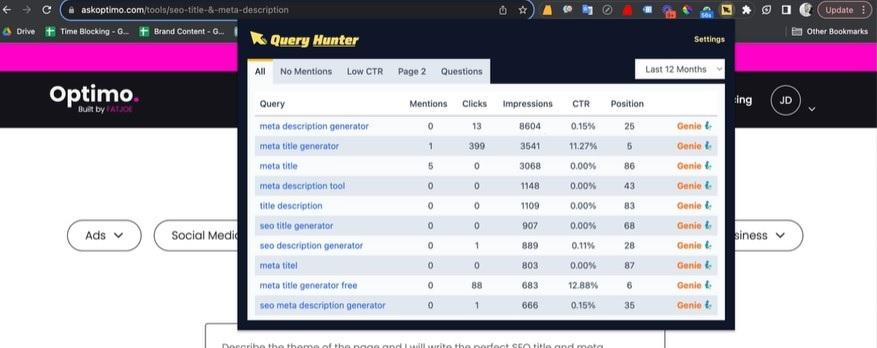
If a keyword generates a lot of impressions or ranks below position 10, make sure you’re addressing it in your content.
Integrating these queries can help you capitalize on untapped traffic potential.
You can also use the “Questions Tab” to find more related keyword questions people are searching for on Google.
Answer The Public
Unlike traditional keyword tools that provide a data table, Answer The Public visualizes questions and long-tail keywords around your topic.
Enter a broad keyword related to your niche, and you’ll be presented with visualized data:
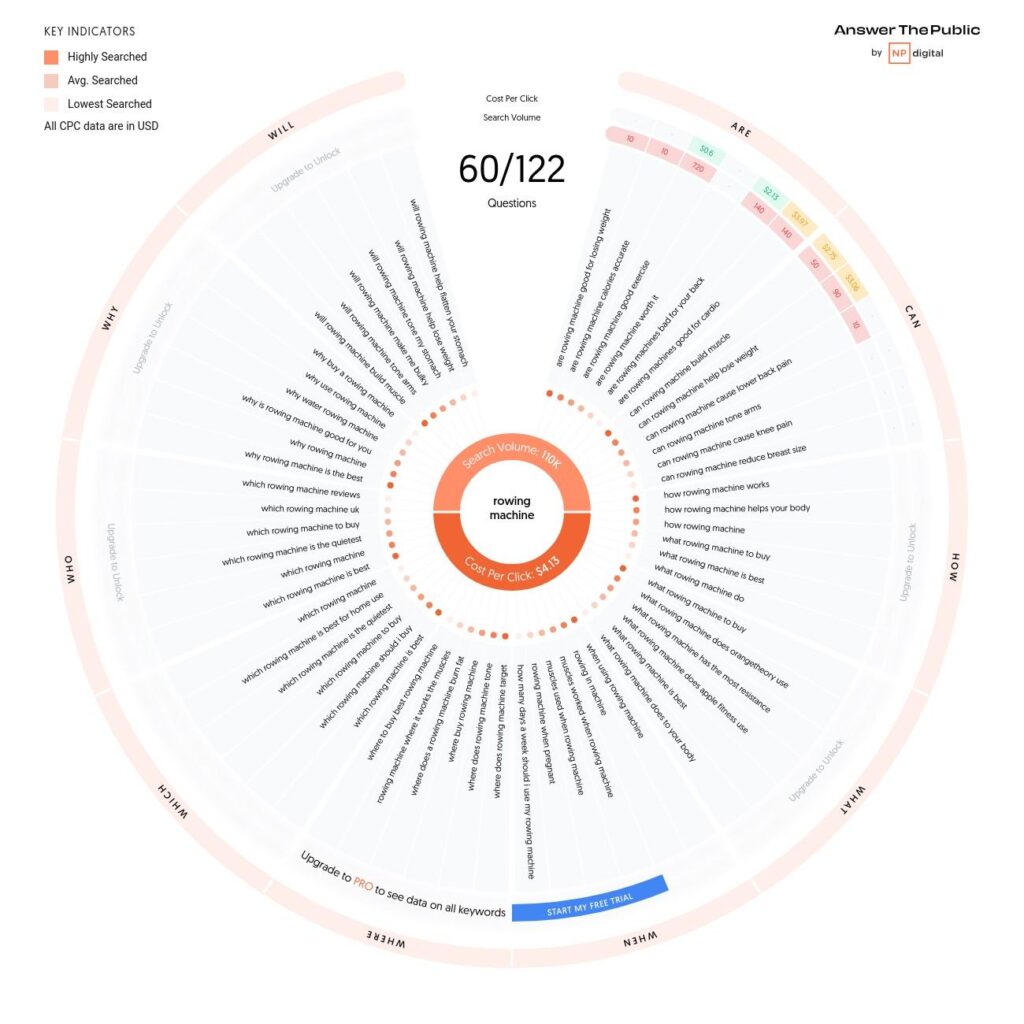
Answer: The Public categorizes long-tail keywords into three categories:
Questions
Related search queries containing words like “how,” “what,” “where,” “when,” “why,” and “which.”
Prepositions
Based on terms like “with,” “near,” and “for.” These prepositions expand on the different contexts around a search query.
Comparisons
These juxtapose your keyword with terms like “and,” “or,” “versus,” etc. Comparison keywords usually have a highly commercial search intent.
Once you’ve found some potential long-tail keywords, head back to Ahrefs or Semrush to check out the search volume and competition.
How to Conduct Long-Tail Keyword Research
Here’s how to put these tools to use and find a bunch of winning long-tail keywords.
Start with a vague topic idea. In this case, let’s look into gardening tools.
Google search suggestions and related searches are an excellent place to get started.
Typing “gardening tools for” into Google triggers the autocomplete feature.

Now, we have a bunch of more topics to dig into.
Typing in “gardening tools for seniors” reveals even more specific long-tail keywords.

Searching for this keyword and scrolling to the bottom of the page reveals Google’s related searches.

And now we could go deeper!
Looking into “gardening tools for seniors,” it’s clear that older people might need special tools for gardening. They might want tools that are easier to grip, lighter, or don’t require bending over too much.
Take note of everything of interest, plug it back into Google, and go further down the rabbit hole of search suggestions.
Another source of inspiration is the Google “People also ask” section.
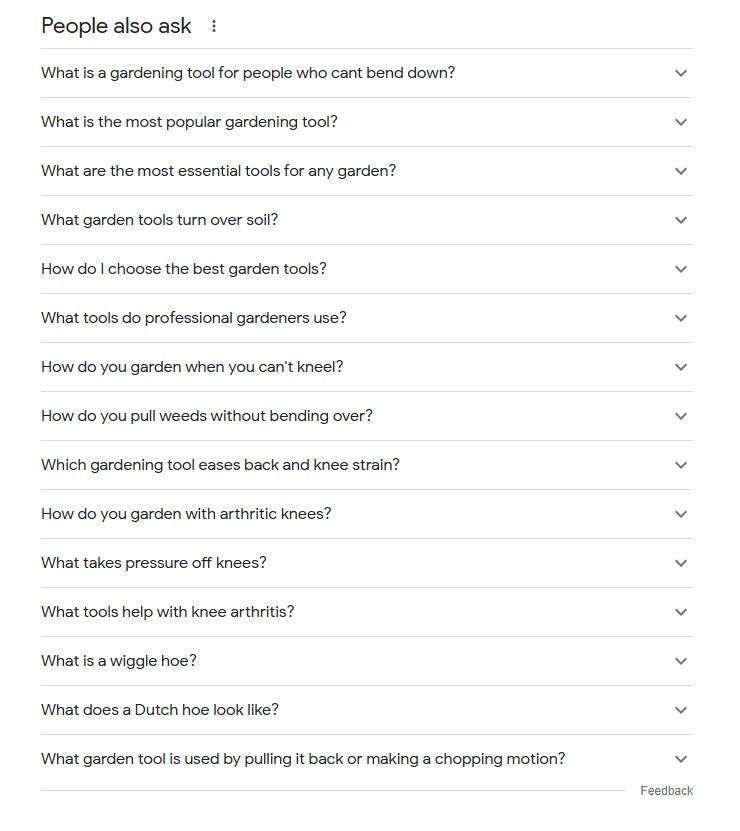
Keep jotting down different questions, topics, and keywords that sound of interest.
Finally, take all of the ideas you’ve generated and throw them into Ahrefs or Semrush. First, check the search volumes of the keywords you’ve chosen.

After that, look at the related keyword ideas to find more long-tail opportunities.
You can apply your own custom filters to narrow in on low-competition keywords.
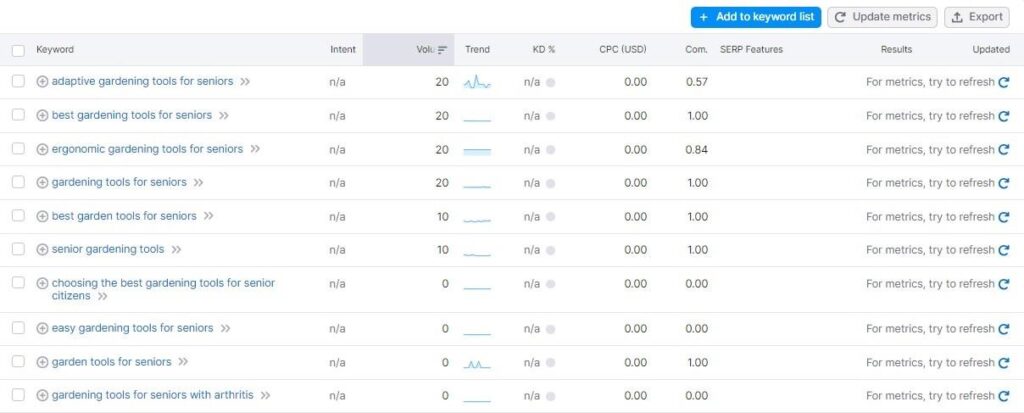
If you need help picking out the right search queries, check out our guide on keyword value. You’ll learn how to pick out long-tail keywords that can really move the needle for your clients.
You can also use our free SEO Value Calculator to quickly judge the potential of a search term while you’re analyzing the SERPs.
How to Optimize for Long-tail Keywords
Once you’ve identified relevant long-tail keywords, optimizing your content is the next step.
Here’s how to do it:
Understand the Search Intent
The first step is to determine the user intent behind the search.
This is relatively easy for long-tail keywords. These terms are typically more specific and give you a clearer insight into what the searcher is looking for.
Start by analyzing the keyword itself.
Does it include transactional terms like “buy” or “price”? Or is it more informational, like “how to” or “what is”?
For example, “How to care for succulent plants” is clearly informational.
On the other hand, “buy lightweight gardening tools for seniors” has a transactional intent. The searcher is looking to make a purchase.
You can also look at the top-ranking pages for the long-tail keyword. Are they blog posts, product pages, or something else?
This shows you what Google thinks is the most relevant content for that query.
Create Content Targeting the Long-Tail Keyword
Once you’ve worked out the search intent, create content that addresses it directly.
If it’s an informational query, make sure your content is comprehensive and answers all potential questions a searcher might have about the topic. Use the long-tail keyword naturally in on-page elements like the title, meta description, and headers.
If it’s transactional, highlight the features and benefits of your product or service. You can include user reviews, testimonials, or comparison charts to add value and boost conversions.
Add FAQs to Your Existing Blog Content
An easy way to target long-tail keywords is by adding a Frequently Asked Questions (FAQ) section to your blog post content.
Each answer in your FAQ section should be clear and to the point.
Naturally, including relevant long-tail keywords can help you rank for multiple queries around your main topic.
🚀 Growth Hack: Add FAQs to your content, product pages, etc. Markup FAQs using Google’s FAQ schema for added benefit. FAQs allow you to target long-tail keywords that bring in organic traffic. #tweet100
— Mushfiq (The Website Flip) (@TheWebsiteFlip) September 20, 2021
You can increase your ranking potential by implementing FAQ schema markup.
This structured data helps search engines understand the content on your page.
It can also help you claim rich results where your questions and answers are directly displayed in the search results.
Check out our schema markup guide to learn how to add schema to your pages.
Get Better Client Results With Long-tail Keywords
If you want to achieve quick SEO wins for your clients, you need to focus on the long tail.
While everyone is battling for those few highly competitive search terms, smart agencies quietly target long-tail keywords. These keywords may have lower search volumes individually, but they add up quickly.
Plus, they’re often easier to rank for, which means faster results.
Become a Pro at SEO
Join 65,000 others and learn the secrets to SEO success with our weekly blog posts.
